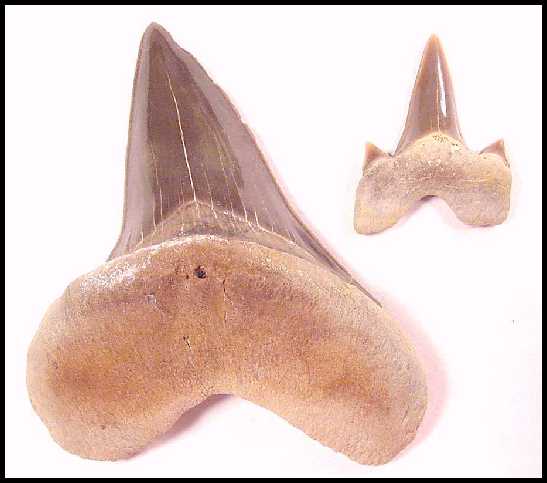
SHARKS OF KANSAS
Copyright © 2003-2014 by Mike Everhart
Last updated 01/21/2014
(At far left, Cretoxyrhina mantelli; at left, Cretalamna appendiculata in lingual view - both from the Smoky Hill Chalk
 |
SHARKS OF KANSAS Copyright © 2003-2014 by Mike Everhart Last updated 01/21/2014
(At far left, Cretoxyrhina mantelli; at left, Cretalamna appendiculata in lingual view - both from the Smoky Hill Chalk |
I have referred to the period from April of 2002 through July 2003 (and into the present) as the "Year of the Shark" at Oceans of Kansas. In spite of my primary interest in marine reptiles, I find that I have been drawn into working with the remains of ancient sharks. It has been an interesting and educational opportunity.
The discovery of a very large (7 m) Cretoxyrhina mantelli "Ginsu Shark" started things off for me in late April, 2002. Then, in August, my wife and I recovered the fragmented remains of a Lower Permian shark called Ctenacanthus from near Herington, Kansas. In June, we were introduced to the shark fauna from the North Sulfur River in Texas, and more importantly, to the use of a binocular microscope in the recovery of tiny shark teeth and scales. Needless to say, it was a whole new world. Later in the fall, my wife and I, with the help of Earl Manning and Donald Hattin, started working on a fish tooth conglomerate from the Blue Hill Shale (Middle Turonian) of Jewell County. My wife (mostly) and I hand picked hundreds of tiny selachian and bony fish teeth from a matrix that was was literally made up of thousands of Enchodus teeth. Although documented from other localities in the Midwest (Texas, South Dakota, Canada), many of the shark species we found had never been reported from Kansas. That study resulted in an abstract that was accepted for the 2003 Society of Vertebrate Paleontology annual meeting, and will eventually produce a paper. In the spring of 2003, I worked with several of my friends (Tom Caggiano, Kenshu Shimada, and Shawn Hamm) on several posters and a presentation, mostly about ptychodontid sharks from the Smoky Hill Chalk, which were given at the 4th annual Paleontology Symposium at the annual Kansas Academy of Science meeting. Then in June of 2003, I started working on the fauna of the Kiowa Shale (Middle Albian, ~110 mya) with Shawn Hamm, and discovered a few more "new" species for Kansas. Kenshu Shimada and I will have a paper published this fall on the latest occurrence of Ptychodus mammillaris in Kansas, and I am now working with Michelle Darnell on her discovery of another P. mammillaris tooth in the Fairport Chalk Member of the Carlile Shale. Then, in July, 2003, I was contacted by Keith Ewell, who was collecting shark teeth from the Lower Permian, and began to learn more about that shark fauna. "
In October 2003, we presented our "Lovewell Fauna" (fish tooth conglomerate layer of the upper Blue Hill Shale Member of the Carlile Shale, middle Turonian) as a poster at the annual meeting of the Society of Vertebrate Paleontology:
| Everhart, M. J., P. Everhart, E. M. Manning, and D. E. Hattin. 2003. A Middle Turonian marine fish fauna from the Upper Blue Hill Shale Member, Carlile Shale, of north central Kansas. Journal of Vertebrate Paleontology, Volume 23 (Supplement to Number 3): 49A.(Abstract) (Picture 1) (Picture 2) - see abstract below |
Sharks have lived in the oceans that once covered Kansas for almost as long as there have been sharks. While most of the shark teeth and other shark remains shown on this page are from the Cretaceous Period of the Mesozoic, the Paleozoic shark teeth shown at the bottom include examples of some of the first vertebrate remains described from Kansas by Joseph Leidy in 1859. The ages of the shark teeth shown on the page progress from the youngest (Late Cretaceous) shark remains to the oldest (Lower Permian) as you go downward.
You can now download a copy of this early article on Kansas sharks by S.W. Williston - Provided by the Kansas Geological Survey.
Williston, S. W. 1900. Cretaceous fishes: Selachians and Pycnodonts. University Geological Survey Kansas VI pp. 237-256, with pls.
Cretoxyrhina mantelli: The Ginsu Shark*
* AUTHORS NOTE: Over the past several years, we have found a number of instances where the fossilized ‘parts and pieces’ of mosasaurs are all that remained of some sort of feeding activity. In some cases, these fossils have been partially digested by something big enough to swallow a large piece of a mosasaur. In others, there are embedded pieces of teeth from the large lamnid shark, Cretoxyrhina mantelli. In one well documented specimen (FHSM VP-13283), there were embedded Cretoxyrhina teeth, two vertebrae that had been bitten completely through, and the evidence of partial digestion (Shimada, 1997; Everhart, 1999). We were left with the conclusion that it was this large and apparently very powerful shark that was feeding on mosasaurs. Since the shark had no common name in the literature, and since it fed by ‘slicing’ up its victim into bite-size pieces, we decided that the title “Ginsu Shark”, was an appropriate, descriptive (and somewhat humorous) name for this awesome creature. Ginsu©, of course, refers to a brand of knives that were advertized on television years ago for their sharp blades and ability to "slice and dice."
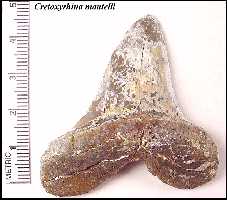 |
Left: "Ol' Big and Ugly": the largest (52 mm) Cretoxyrhina
mantelli tooth in my collection. From Gove County, Early Santonian. It's a shed tooth
from one VERY large shark. Right: The first Cretoxyrhina mantelli tooth I ever collected some thirty years ago, and still one of the prettiest I've seen; Ellis County, Late Coniacian. |
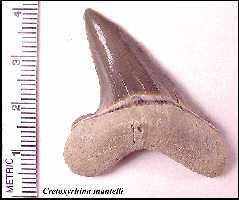 |
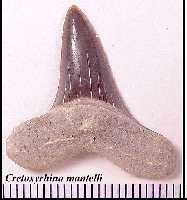 |
Left: Lingual and labial views of a nearly perfect Cretoxyrhina
mantelli tooth. Gove County, KS, Late Coniacian. (see picture below for size
comparison) Right: Labial and lingual views of a not-so- perfect C. mantelli tooth found in October, 2003. The labial side of the tooth (last picture) is rough, and appears to have been damaged during formation. Trego Co., Late Coniacian. |
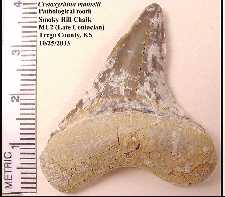 |
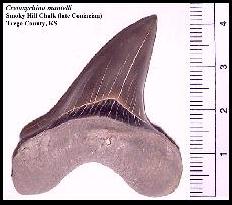 |
LEFT: A large and nearly perfect Cretoxyrhina mantelli
tooth found by Keith Ewell in Trego County, KS. Photos by K. Ewell. RIGHT: This giant anterior tooth, collected many years ago by Vi and Earnest Fick, is the largest Cretoxyrhina mantelli tooth that I have ever seen. Shimada (1997a) reported the largest Cretoxyrhina teeth that he had examined were about 54 mm in total height. Although the broken tip of this tooth has been reconstructed, it would have measured at least 70 mm. |
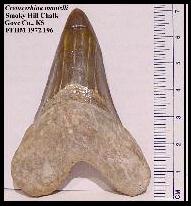 |
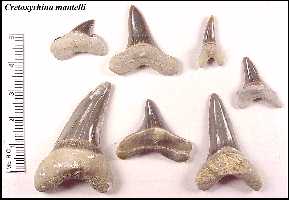 |
Left: An assortment of Cretoxyrhina mantelli from
various locations in the mouth of the shark. Mostly Gove County, Late Coniacian. Right: Two quite large and nice Cretoxyrhina mantelli teeth that demonstrate what a few months of exposure can do to sharks teeth. Click here to see what really happens when "Bad things happen to good teeth" due to weathering and to cattle/deer stepping on them. Gove County, Late Coniacian. |
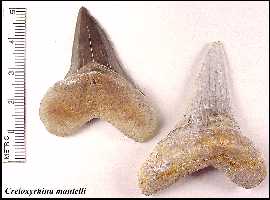 |
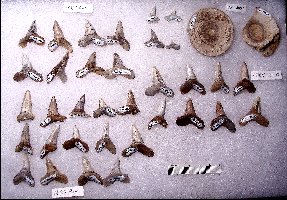 |
Left: Part of a group of 117 Cretoxyrhina
mantelli teeth (and two vertebrae) originally from a single shark
(FHSM VP-14004). The photo shows the large variety of shapes and sizes of
teeth that were a part of the dentition of this species. Unfortunately,
these teeth represent the 'left-over' remains of a nearly complete
specimen that was poached (and essentially destroyed) from private
property.
Ten Squalicorax falcatus teeth associated with the remains are curated as FHSM VP-14005) Right: A closer view of several of the teeth of FHSM VP-14004. See Bourdon and Everhart (2011) for additional photos and analysis of this specimen. |
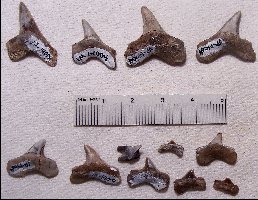 |
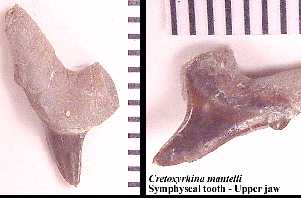 |
Left: Lingual and labial views of a symphysial tooth from the
upper left jaw of a fairly large Cretoxyrhina mantelli. Right: A diagram showing the arrangement of teeth in the front of the upper and lower jaws of Cretoxyrhina mantelli. Note that the symphysial teeth are in the center of both the upper and lower jaws. Click here for a lateral view of the upper and lower jaws.
|
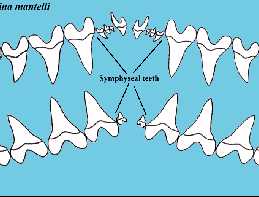 |
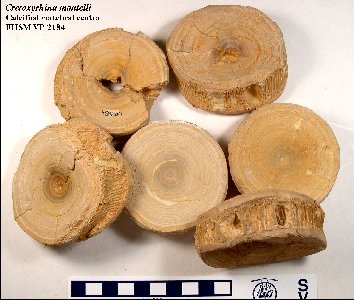 |
LEFT: Calcified vertebral centra from a large Cretoxyrhina
mantelli (FHSM VP-2184). The specimen included over 100
centra, but only a few teeth.
RIGHT: Overview of the entire FHSM VP-2184 specimen. |
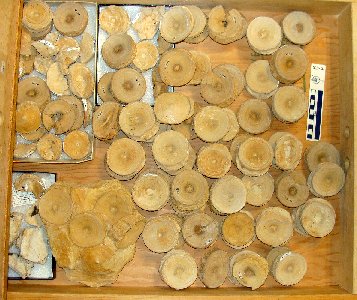 |
Cretalamna appendiculata
Scapanorhynchus cf. S. raphiodon - Goblin Sharks
Johnlongia sp.
Squalicorax - Crow sharks
NOTE: While I can honestly take credit for being the first to use the term "Ginsu shark" as a common (but appropriate) name for Cretoxyrhina mantelli (above), the origin of the term "Crow Shark is a bit more mysterious. I don't know when it was first used or who used it, but I suspect it goes back to the meaning of the Greek word "Corax." The genus name, "Squalicorax" was originally just "Corax." (e.g. Corax falcatus Agassiz 1843). Corax is a name found in Greek mythology, but also is the species name for the common raven (a bird) of Europe (Corvus corax). (From Wikipedia, in regard to Corvus corax, "the specific epithet, corax/???a?, is the Greek word for "raven" or "crow". Whitley (1939) changed the genus name to Squalicorax. At some point, Squalicorax was given the common name, Crow shark.
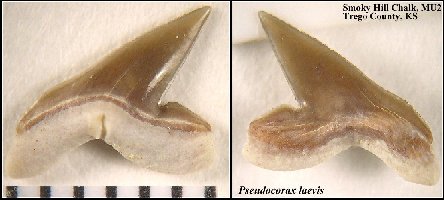 |
Left: Pseudocorax laevis (FHSM VP-15823) is a rare shark
species found in the lower (Late Coniacian) Chalk. This tooth was found by Keith Ewell in
2004 in Trego County (below MU 2). Note the lack of serrations. Right: An unusual Squalicorax sp. tooth in labial (left) and lingual views that was found in situ under the recently discovered dinosaur vertebrae. Note the very weak serrations on the main cusp and the lack of serrations on the posterior accessory cusp. (Upper Coniacian) |
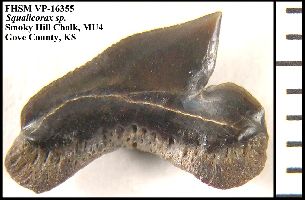 |
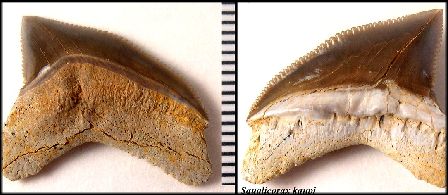 |
Left: A Squalicorax kaupi tooth in lingual (far left) and
labial views. Tooth was found in the Smoky Hill Chalk of Gove County above Hattin's marker
unit 8. Right: A typical Squalicorax kaupi tooth (FHSM VP-17566), from the Early Campanian chalk of Logan County. Note the change in the shape of the cusp and the root. |
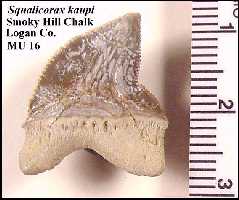 |
 |
Left: A portion of the preserved jaw cartilage of a Squalicorax
kaupi in the Sternberg Museum (FHSM VP-2213) with 5 teeth in their natural
arrangement (labial view). Right: Detail of the jaw of FHSM VP-2213 showing two teeth in labial view. |
 |
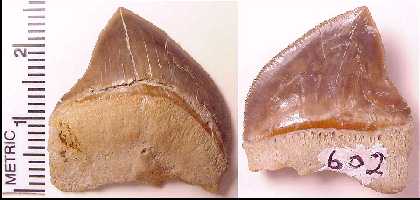 |
Left: A typical Squalicorax pristodontus tooth, but a
rare discovery at the very top of the Smoky Hill Chalk - early Campanian, Logan Co, KS.
This tooth and two others were collected by Pete Bussen. Right: Squalicorax "what?" ... One of several specimens of an unusual tooth form from the lower Smoky Hill Chalk collected by Keith Ewell. |
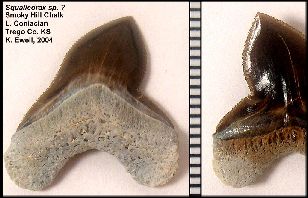 |
Ptychodontids - Pavement-toothed or Crusher sharks
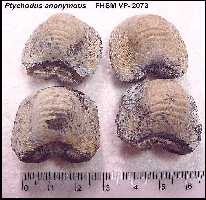 |
Ptychodus anonymus is one of 4 species of ptychodontid sharks
found in the Smoky Hill Chalk. Left: Ptychodus anonymus teeth, from the medial row. Right: Ptychodus anonymus posterior lateral teeth (FHSM VP-14854) from the lower chalk of Gove County. |
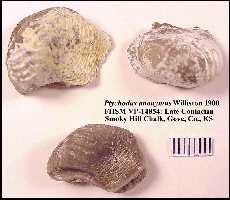 |
 |
Ptychodus mortoni is the only ptychodontid species which has
ridges radiating from the center of the tooth. All other species have ridges that run more
or less parallel across the crown. Left: Ptychodus anonymus (FHSM VP-2238) jaw plate in the collection of the Sternberg Museum. Right: Ptychodus mortoni (FHSM VP-336) |
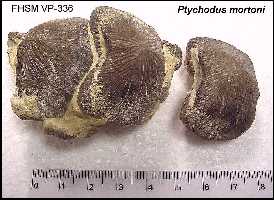 |
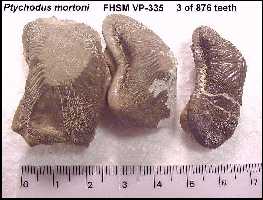 |
Left: Ptychodus mortoni teeth (FHSM VP- 335) note
the excessive wear on the tooth at far left. Right: Detail of a Ptychodus mortoni lower jaw plate (FHSM VP-14785) that I found in Gove County in 1990. |
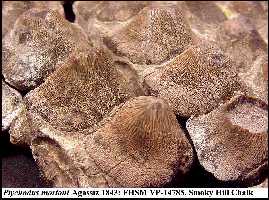 |
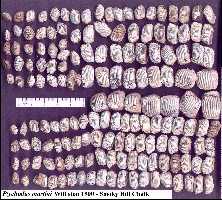 |
Left: Ptychodus martini - 100+ associated teeth, Gove
Co., KS (Late Coniacian). Found by Shawn Hamm in Gove County. Right: Detail from the type specimen of Ptychodus martini Williston 1900 in the collection of the University of Kansas (KUVP 55271). |
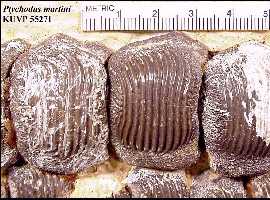 |
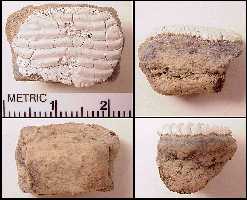 |
Left: A badly weathered P. martini found by Pam Everhart
in the lower chalk of Gove County, KS. Note the flat aspect of the crown in both of these
specimens. No other tooth crown of a Ptychodus species is quite this flat. Right: Ptychodus martini -Left: A single tooth from the Late Coniacian Smoky Hill Chalk of Trego County, KS. Found by Keith Ewell, 11/2003. |
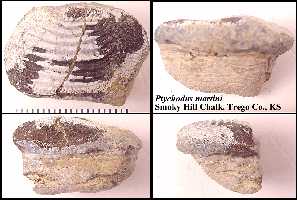 |
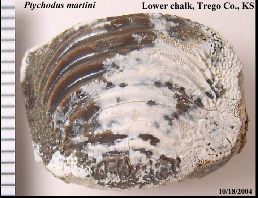 |
LEFT: Occlusal and medial (?) views of a tooth of Ptychodus
martini found by Pam Everhart in the low chalk of Trego County (10/2004). The
identification is based on the description provided by S.W. Williston, 1898. RIGHT: One of the smaller 'symphysial' teeth that serve as spacers between the two medial rows of large teeth in the upper jaw of a Ptychodus (found by Keith Ewell, 10/2004). |
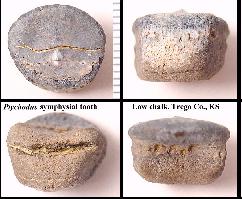 |
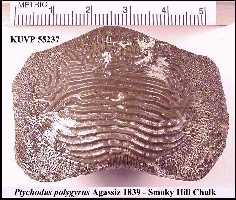 |
Left: A large Ptychodus polygyrus (KUVP 55237) in the
collection of the University of Kansas, This specimen was the subject of one of the first
photographs ever published of shark teeth (Williston, 1900).
Right: Another large P. polygyrus (FHSM VP-76) at the Sternberg Museum. Note that this species has now been re-identified by Hamm (2010) in the Western Interior Seaway as Ptychodus marginalis. |
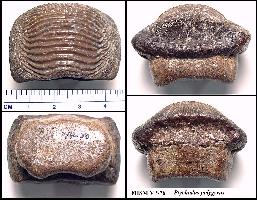 |
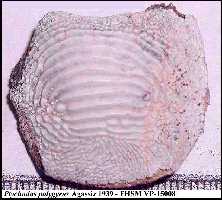 |
Left: A Ptychodus polygyrus in the collection of the
Sternberg Museum (FHSM VP-15008); Gove Co., KS (Late Coniacian). Found by Tom Caggiano. Right: Ptychodus mammillaris lateral tooth -FHSM VP-14022, from near the base of the Fort Hays Limestone, (Lower Coniacian) , Ellis Co., KS. Collected by Mike Everhart. |
 |
Rhinobatos incertus - Guitar fish
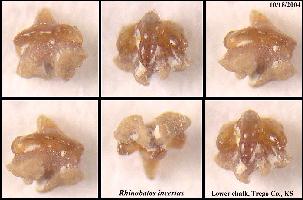 |
Left: The first Rhinobatos incertus (male
breeding phase) tooth to be found in the lower (late Coniacian) Smoky Hill Chalk. Although
not common anywhere in the Niobrara, Rhinobatos has been previously reported from
the upper chalk (early Campanian) by Stewart (1990) and most recently from the middle
(Santonian) by Beeson and Shimada (2004). An unreported Rhinobatos tooth
from Kansas is in the collection of the Los Angeles County Museum of Natural
History. (see Everhart, 2007) Right: A total of six small Rhinobatos teeth were recovered from the same sample. |
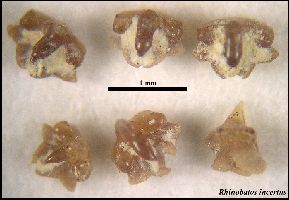 |
Everhart, M. J. 2005. New stratigraphic records (Albian-Coniacian) of the guitarfish, Rhinobatos incertus (Chondrichthyes; Rajiformes), from the Cretaceous of central and western Kansas. Journal of Vertebrate Paleontology, 25(Supplement to 3): 55A. Guitarfish (Rhinobatidae) are a conservative group of extant rays with worldwide distribution and a fossil record that extends back to the Late Jurassic of Europe. Modern representatives of the order inhabit shallow tropical and sub-tropical waters, at depths less than 200 m, and are also found in fresh water environments. The most common fossil remains are isolated teeth (less than 2 mm) although complete specimens are known. In North America, the earliest documented Rhinobatos sp. teeth were recovered from the Early Cretaceous (Lower Albian) of Texas. Rhinobatos sp. has been reported in the western interior from the Albian-Campanian of Texas, the Turonian and Santonian of Kansas, the Cenomanian of Nebraska, the Cenomanian-Turonian of New Mexico and South Dakota, and the Coniacian of Saskatchewan, Canada. Recent discoveries of Rhinobatos incertus teeth in the Cretaceous of Kansas indicate a reasonably continuous presence of the species in a variety of marine environments within the Western Interior Sea from the Upper Albian to the Lower Campanian. New Kansas records of R. incertus teeth are: 1) Kiowa Shale (Upper Albian), McPherson County; 2) Dakota Sandstone - Graneros Shale contact (Middle Cenomanian), Russell County; 3) Basal Lincoln Limestone Member, Greenhorn Limestone (Upper Cenomanian), Russell County, and; 4) Smoky Hill Chalk (Upper Coniacian), Trego County. The only previous reports from Kansas include the Blue Hill Shale Member, Carlile Shale (Middle Turonian), Jewell County, and the Smoky Hill Chalk (Middle Santonian and Lower Campanian), Gove and Logan counties. Depositional settings varied from marginal marine sandstone to near-shore shales and deeper water (< 200 m) limestone and chalk during the Kiowa-Skull Creek, Greenhorn and Niobrara Cyclothems. The earliest (Upper Albian) and smallest (< 0.5 mm) R. incertus teeth were found in a shelly lag deposit composed predominately of Turritella belviderei. Hundreds of R. incertus teeth were collected near the top of Dakota Sandstone, and the species represented nearly one-third of about 1600 selachian teeth picked from a fish tooth conglomerate in the upper Blue Hill Shale. |
Superorder: Holocephali
Order: Chimaeriformes
Family: Chimaeridae (Ratfishes) -
 |
LEFT: A modern ratfish (Chimaea monstrosa Linnaeus 1758 - also called the Rabbit fish). Although many species of these fish have been around since the Triassic, their remains are rare in the fossil record. Most chimaeroid remains are limited to teeth (tritors), fin spines and paired jaw plates because they are a cartilaginous fish like the sharks described above. Although the jaw plates (see below) appear to be bone, they are actually composed of calcified cartilage. Modern ratfishes typically use their crushing dentition to feed on hard shelled prey. The tritors are composed of hypermineralized cartilage. |
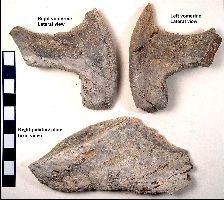 |
LEFT: Recently discovered jaw elements (FHSM VP-16685) of a Late
Cretaceous chimaeroid (ratfish). This is only the second known specimen of a ratfish from
the Smoky Hill Chalk. A dorsal fin spine was discovered by H.T. Martin along Hackberry
Creek (Gove County) about 1900, and was sold to the British Museum of Natural History (BMNH P10343, see Stahl, 1999, fig. 143).
Ratfish have three pairs of jaw plates (vomerines, palatines and mandibulars. The
specimen was identified by Ken Carpenter (Denver Museum of Natural History) in August,
2006, and also by David Parris (New Jersey Museum of Natural History) and David Cicimurri
(Bob Campbell Geology Museum, Clemson University). PUBLICATION: Cicimurri, D. J., D. C. Parris and M. J. Everhart. 2008. Partial dentition of a chimaeroid fish (Chondrichthyes, Holocephali) from the Upper Cretaceous Niobrara Chalk of Kansas, USA. Journal of Vertebrate Paleontology 28(1):34–40. |
Late Cretaceous: Upper Middle Turonian (90 mya) - Carlile Shale Formation
Codell Sandstone Member of the Carlile Shale - Jewell County, Kansas
Blue Hill Member of the Carlile Shale Formation (Middle Turonian)
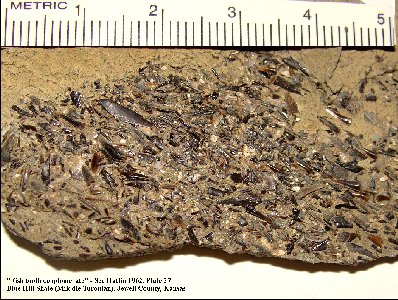 |
Everhart, M. J., P. Everhart, E. M. Manning, and D. E. Hattin.
2003. A Middle Turonian marine fish fauna from the Upper Blue Hill Shale Member,
Carlile Shale, of north central Kansas. Journal of Vertebrate Paleontology, Volume 23
(Supplement to Number 3): 49A.(Abstract) (Picture 1) A diverse piscine fauna is reported for the first time from the Late Cretaceous Carlile Shale of Kansas. The relatively shallow (<100 m) marine assemblage derives from a thin (1-3 cm) fish-tooth conglomerate which lies 3-4 m below the top of the formation near Lovewell Reservoir in Jewell County, and accumulated during the late Middle Turonian regressive deposition in the Greenhorn Sequence. In contrast to larger material from transgressive lag faunas at the bases of sequences, the Lovewell fauna consists mostly of very small material (teeth, dermal denticles, vertebrae, and scales), suggesting winnowing by weak, intermittent currents. Due to size sorting for smaller particles, and the presence of a nearby nursery ground, teeth of juvenile individuals are unusually well represented. The fauna consists of 17 taxa (first records for Kansas are marked with an asterisk): 7 sharks (Ptychodus whipplei, *Chiloscyllium greeni, *Cantioscyllium d. decipiens, Otodus appendiculatus, Scapanorhynchus r. raphiodon, Squalicorax falcatus, and *Scyliorhinus sp.); 4 rays (*Rhinobatos incertus, *Ptychotrygon triangularis, *Ischyrhiza mira schneideri, and *Brachyrhizodus mcnultyi); and 6 bony fish (Hadrodus priscus, Pachyrhizodus minimus?, Xiphactinus a. audax, *a small unidentified albulid, Enchodus gladiolus and E. petrosus). As is found in many Late Cretaceous assemblages of marine shallow-water fishes, Scapanorhynchus is the most abundant shark and Enchodus petrosus is the most abundant of the bony fish. Both occur in far greater numbers than recorded in the younger, deeper water fauna of the Niobrara Chalk. Several elements of the fauna, however, do indicate a nearby deep-marine habitat (Ptychodus, Chiloscyllium, Otodus and Scyliorhinus). The rare albulid teeth may evince a small estuarine component, but neither freshwater nor terrestrial vertebrate remains are represented. This Kansas fish fauna closely resembles that from the Carlile of SW South Dakota, but less closely resembles that from the Carlile of NE South Dakota. The Lovewell fauna suggests a relatively shallow marine environment located far from the eastern shore of the Western Interior Sea. LEFT: A small fragment of the "Fish Tooth Conglomerate" of Hattin (1962), rediscovered in 2002 by Mike and Pam Everhart. |
Cretodus crassidens - Large lamniform shark
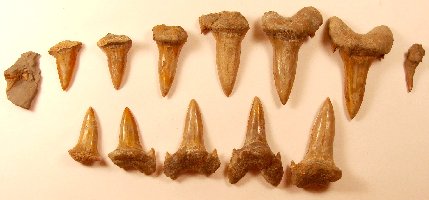 |
LEFT: These are Cretodus crassidens teeth in lingual view
that we collected on June 6, 2010. The arrangement is completely artificial,
based only on decreasing size toward the back of the shark's mouth, but
the fact that several of the smaller teeth are leaning different
directions suggests that we have teeth from opposing jaws (upper / lower
or right / left). A complete upper and lower
jaw set would look something like this for Cretoxyrhina mantelli.
RIGHT: A close-up of one of the larger anterior teeth from this specimen. This shark would have been comparable in size and feeding behavior to a modern Great white, or to a Cretoxyrhina mantelli from the Smoky Hill Chalk. |
 |
Cretalamna appendiculatus
 |
Cretalamna appendiculatus, Jewell Co., KS. Occur rarely in the fish tooth conglomerate, but are more common elsewhere.. |
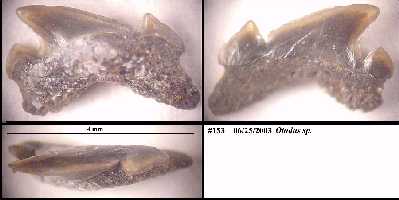 |
Scapanorhynchus r. raphiodon - Goblin Shark
Squalicorax falcatus - Crow shark
Scyliorhinus sp. (Cat Shark)
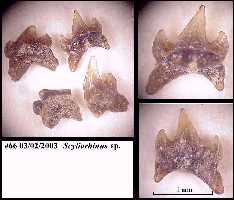 |
LEFT AND RIGHT: Lateral teeth of Johnlongia sp., Jewell Co., KS. Rare and very small. |
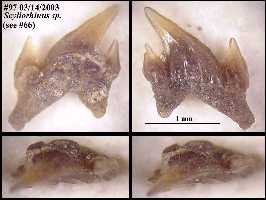 |
Chiloscyllium greeni - Bamboo shark
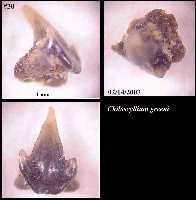 |
Chiloscyllium greeni, Jewell Co., KS. These teeth are very small (1 mm) and quite rare. |
Cantioscyllium d. decipiens
| Although we have found Cantioscyllium teeth in the matrix, they are very rare and in poor condition. (See below) |
Ptychodus whipplei - Pavement toothed or crusher shark
Lonchidion sp. babulskii
Rhinobatos incertus - Guitar fish
Ptychotrygon triangularis - Sclerorhynchid sawfish
Ischyrhiza mira schneideri: Sclerorhynchid sawfish
Brachyrhizodus (Pseudohypolophus) mcnultyi - Primitive eagle ray (Mid-dorsal scales only)
Upper Cretaceous - Lower Turonian: Fairport Chalk, Southern Ellis County:
Upper Cretaceous - Lower Turonian: Fairport Chalk, western Russell County:
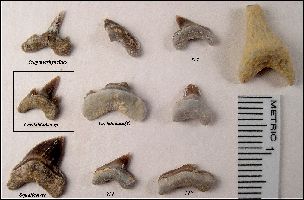 |
Left: A variety of Late Cretaceous shark teeth collected from an
exposure of the Fairport Chalk, about 20 feet above the Fencepost Limestone in
western Russell County, KS. The tooth in the square box is a juvenile Cardabiodon sp. (Larger photo HERE) and represents
the upper occurrence of the genus in Kansas (kudos to Mikael Siverson (pers. comm.
01/2008) for recognizing this tooth. The large "lump" at upper right in the
picture is a badly weathered Cretoxyrhina mantelli (?) tooth. Note that the teeth
marked as "???" are possibly an unidentified species of Squalicorax
(see detail below left). Right: A variety of shark teeth collected one week later from the same locality as above. This collection includes a crusher shark tooth (Ptychodus anonymus). |
 |
 |
Left: Detail of center tooth in bottom row above.
This tooth is only weakly serrated and does
not have the typical serrated edge found on most Squalicorax teeth. Right: Detail of two teeth from the group photo, above left. At near right is a tooth of Scapanorhynchus cf. raphiodon; a far right is a similar-sized, but previously mis-identified tooth from Cardabiodon sp. (pers. comm. Mikael Siverson, 01/2008). Additional views HERE. |
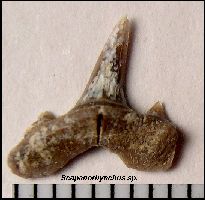 |
Upper Cretaceous - Lower middle Turonian - top of the Pfeifer Shale Member of the Greenhorn Limestone Formation:
Upper Cretaceous - Upper Cenomanian: Base of Lincoln Limestone Member of the Greenhorn Limestone Formation:
Locality #1: Southeastern Lincoln County.
Locality #2: Eastern Russell County
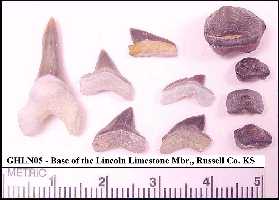 |
Left: The teeth of three shark species from a lag deposit at the
base of the Lincoln Limestone Mbr. of the Greenhorn Limestone Fm. - Left to right: Cretoxyrhina
mantelli, Squalicorax falcatus and Ptychodus decurrens.
Collection by Keith Ewell / Mike Everhart. (upper Middle Cenomanian) Right: Closer view of the largest Ptychodus decurrens (?) in the group photo at left. A smaller Ptychodus tooth is pictured HERE. |
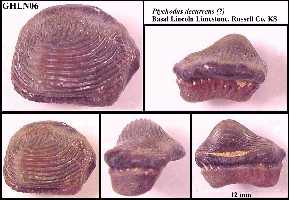 |
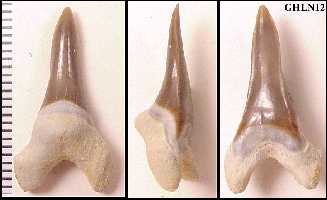 |
Left: Three views of the large Cretoxyrhina mantelli
anterior tooth in the picture above. <GHLN12> Right: Three views of a large and nicely preserved Cretoxyrhina mantelli tooth that I collected in May, 2004. |
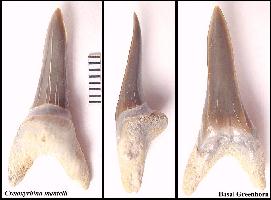 |
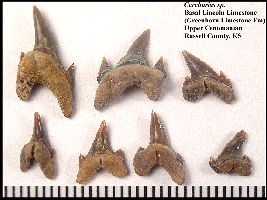 |
Left: I had originally identified this group of teeth teeth
collected from the lower Greenhorn by Keith Ewell as as Carcharias sp., but
Siverson (pers. comm. 01/2008) thinks that the one at top left is Protolamna (see
below) and the one at lower left looks very similar to Roulletia bureaui
Vullo, et al. 2007, a new species named from the Cenomanian-Turonian of France. Larger
pictures are HERE. Right: A single Protolamna sp. tooth in lingual and labial views. Additional views HERE |
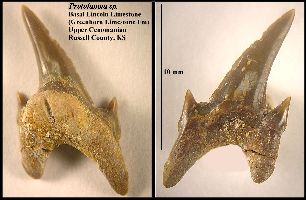 |
 |
Left: A exceptionally well preserved anterior tooth of Squalicorax falcatus in labial and lingual view (about 9 mm). Right: Two of the larger Squalicorax falcatus (?) teeth found at the site. <GHLN07> |
 |
 |
Left: Labial and lingual views of a posterior Squalicorax
falcatus tooth that has been damaged by the impact of another, apparently larger Squalicorax
tooth. Length of the tooth is about 10 mm. A face bite by another shark or some other
dental mishap? Right: A single shark vertebra still in the matrix. Although shark vertebrae are fairly common in the basal Greenhorn, this is one of the largest we found. |
 |
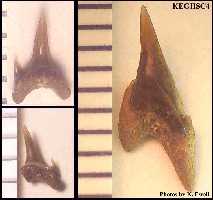 |
Far left: Two recently discovered (11/2003) teeth of Scapanorhynchus
r. raphiodon from the basal Greenhorn. Photos by K. Ewell. Left: A small tooth (9 mm) that is probably a symphysial tooth of Cretoxyrhina or Cretalamna. Photo by K. Ewell. Right: Lingual view of a small (10 mm) Cretalamna appendiculata tooth (Otodus appendiculatus) from the basal Greenhorn. Photo by Keith Ewell. |
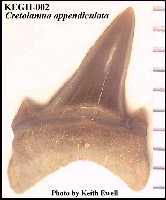 |
Location #3 - Eastern Republic County: The Republic County Historical Museum in Belleville, Kansas, has a display which includes many shark teeth collected by a local landowner and donated to the museum.
Upper Cretaceous - Middle Cenomanian: Top of the Dakota Sandstone Formation:
Locality: Southeastern Russell County.
Everhart, M. J., P. A. Everhart and K. Ewell. 2004. A marine ichthyofauna from the Upper Dakota Sandstone (Late Cretaceous). Abstracts of oral presentations and posters, Joint Annual Meeting of the Kansas and Missouri Academies of Science, p. 48. ABSTRACT: The Dakota Sandstone in Kansas is composed of mudstones and channel sandstone lenses deposited at the mouth of a river flowing into the Western Interior Sea from the northeast during Middle Cenomanian time. The formation is well known for beautifully preserved impressions of deciduous leaves, but has an otherwise poor record for vertebrate remains. A marine ichthyofauna is reported here for the first time from the Upper Dakota Sandstone near Wilson Lake in eastern Russell County. The interbedded sandstones and shales exposed at this locality represent the transition from non-marine, deltaic deposits to a shallow-water, marine environment at the beginning of the Greenhorn Transgression. The micro- and macro-vertebrate faunal assemblage is derived from a two layers of poorly cemented sand within 6 m of the contact with the Graneros Shale. To date, the Wilson Lake fauna consists of 20 taxa: 7 sharks (Hybodus sp., “Polyacrodus” sp., Cretoxyrhina mantelli, Cretalamna appendiculata, Carcharias amonensis, Cretodus semiplicatus, and Squalicorax falcatus); 6 rays (Rhinobatos incertus, Pseudohypolophus mcnultyi, Chiloscyllium greeni, Onchopristis dunklei, Ptychotrygon sp., and “Cretomanta canadensis”); and 7 bony fish (“Coelodus” sp., Hadrodus sp., Pachyamia sp., Lepidotes sp., Enchodus sp., Xiphactinus audax, and Protosphyraena bentonianum). The teeth of Carcharias and Rhinobatos are the most abundant of the sharks and rays, and Enchodus sp. is the most abundant bony fish. The species represented in the Wilson Lake fauna suggest a shallow marine environment located on the edge of a river delta near the eastern shore of the Western Interior Sea. |
|
The two teeth shown
above are the only specimens of this shark from the U. S.. Three other Orectoloboides
teeth were described earlier in 2010 by Underwood and Cumbaa from
Saskatchewan, Canada. See Bourdon,
J. and Everhart, M.J. 2010. Occurrence of the extinct Carpet shark, Orectoloboides,
in the Dakota Formation
(Late Cretaceous; Middle Cenomanian) of |
Hybodus
sp.
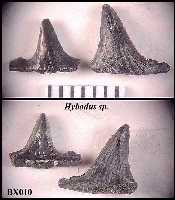 |
LEFT and RIGHT: Meristodonoides sp. (formerly Hybodus sp.) teeth . These isolated teeth are fairly common in the Kiowa Shale. McPherson Co., KS. |
 |
Polyacrodus sp.
Odontaspis (Carcharias) amonensis
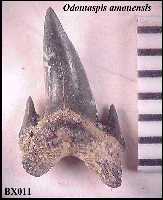 |
Odontaspis (Carcharias) amonensis, McPherson Co., KS. These were the second most common teeth found on the site. |
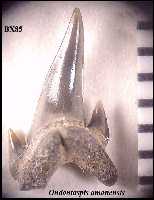 |
Leptostyrax macrorhiza
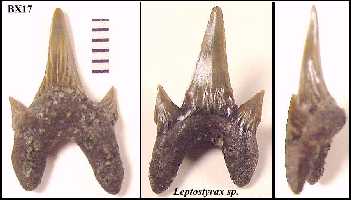 |
Cope (1875, p. 297, pl. XLII) named the first teeth of Leptostyrax
macrorhiza, although he called them Lamna macrorhiza. He noted
that his four specimens were collected in "Ellis County" (more
likely they were collected in Ellsworth or McPherson counties, where the
Kiowa Formation crops out). Williston (1900) noted that the genus was not Lamna
and coined the name Leptostyrax. Williston's species name (bicuspidatus)
for a tooth from the Kiowa Formation of Kiowa County, however, is a junior
synonym of macrorhiza and the resulting scientific name is a
combination of Williston's genus name and Cope's species name.
LEFT: Three views of Leptostyrax macrorhiza, McPherson Co., KS. These are the most common shark teeth found on the site. RIGHT: Labial and lingual views of small Leptostyrax macrorhiza tooth from the Buildex shale quarry, McPherson Co., KS. |
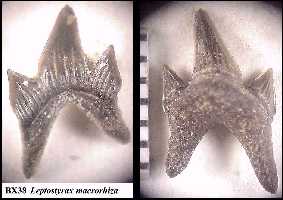 |
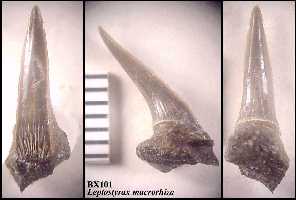 |
LEFT: Central cusp of an anterior tooth of Leptostyrax
macrorhiza, McPherson Co., KS. RIGHT: An anterior tooth of Leptostyrax "bicuspidatus" Williston (FHSM VP-17036) that I found in Kiowa County, July 14, 2006, about 6 m above the base of the Kiowa Shale. This tooth is about 3 cm tall, much larger than any that we recovered from the Buildex shale quarry in McPherson County. Click HERE for an image of a slightly smaller tooth (26 mm, type specimen?) reported by Williston in 1900 from the Kiowa Shale of McPherson County. |
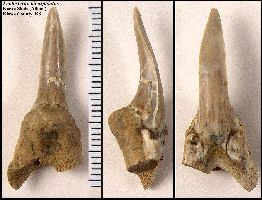 |
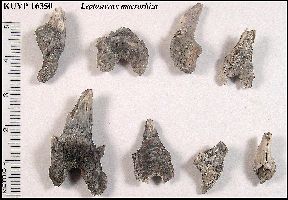 |
LEFT: An associated set of Leptostyrax
teeth (KUVP 16350) from the Kiowa Shale of Clark County. Preservation of teeth in the
shale is normally poor, as is illustrated by this specimen, and the one at right. RIGHT: Four associated Leptostyrax teeth (KUVP 7587) from the Kiowa Shale of Clark County. |
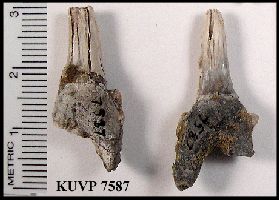 |
Onchopristis dunklei: An early sawfish with barbed rostral denticles.
Brachyrhizodus (Pseudohypolophus) mcnultyi - Primitive eagle ray
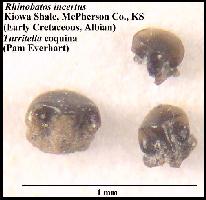 |
Left: Three very small Rhinobatos
incertus teeth collected by Pam Everhart from a shell coquina made up primarily of Turritella
snails. These teeth represent the earliest known record of Rhinobatos in
Kansas. (see Everhart, 2007) RIGHT: This large (almost 1.5 mm across the crown) rhinobatoid tooth (VP-16371) came from the same sample but is probably not Rhinobatos (pers. comm. David Cicimurri, 2007), but in that case, what is it? It is possibly a new and undescribed species of guitar fish from the upper Early Cretaceous of Kansas. Another specimen (FHSM VP-17035) from the basal Kiowa Shale of Kiowa County is shown HERE. |
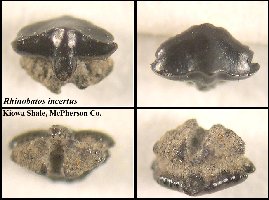 |
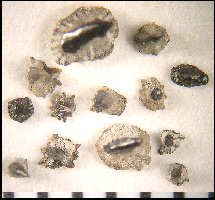 |
LEFT: Tiny, mid-dorsal denticles from small rays,
most likely Rhinobatos. RIGHT: An artist's view of what Rhinobatos incertus may have looked like. |
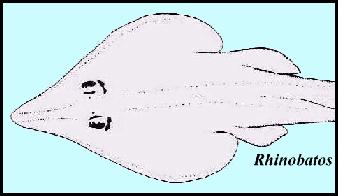 |
Lower Permian - Chase Group (280 mya) - Morris County, Kansas: This specimen was collected from a roadside exposure in August, 2002. The fin spines were assembled from numerous fragments that were recovered by screening the outwash material from the slope. My wife, Pam, did most of the handpicking with a binocular microscope and found all of the small teeth and scales that were associated with the specimen. See the Ctenacanthus web page with more pictures HERE.
Ctenacanthus amblyxiphias Cope 1891-
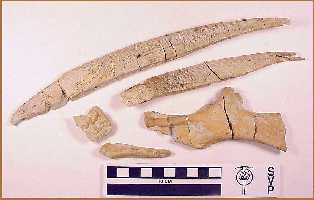 |
Left: Pair of dorsal fin spines, and calcified cartilage denticles
of Ctenacanthus amblyxiphias Cope, Morris Co., KS. (FHSM VP-15012). Right: Cladodus tooth fragments found in association with Ctenacanthus remains, Morris Co., KS. |
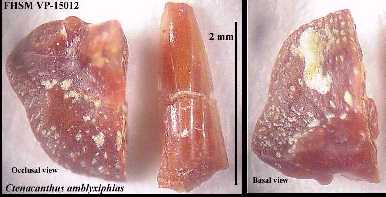 |
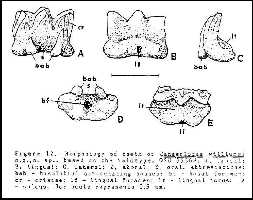 |
Left: Fig. 12, from Hansen (1986), used with permission. Right: Teeth of a small, and rare, cladodont shark, "Zangerlodus williamsi" (unpublished species name; Hansen, 1986), Morris Co., KS. ID by Wayne Itano (9/2003). (Scan courtesy of Wayne Itano) (Click here for larger pic) |
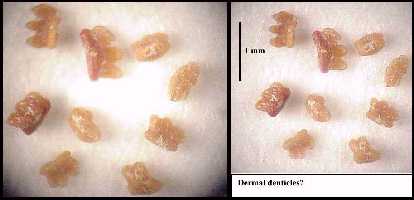 |
 |
Left: Figure 18, from Hansen (1986); used with
permission. Right: "Maiseyodus johnsoni" tooth (unpublished species name; Hansen, 1986), Morris Co., KS. ID by Wayne Itano (9/2003). (Scan courtesy of Wayne Itano) |
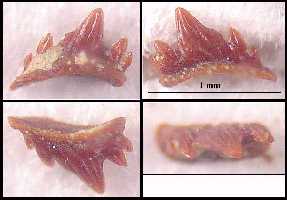 |
Lower Permian - Council Grove Group (285 mya) - Wabaunsee County, Kansas: These teeth were found by a friend of mine who generously allowed me to prepare and photograph them. The specimens are from three productive sites and are shown in more detail HERE.
Cladodus occidentalis Leidy 1859
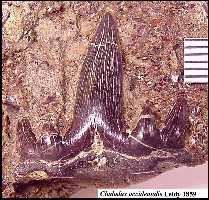 |
Left: Cladodus occidentalis tooth in matrix labial view.Right: Agassizodus corrugatus tooth - Lower Permian of Wabaunsee County, Kansas. |
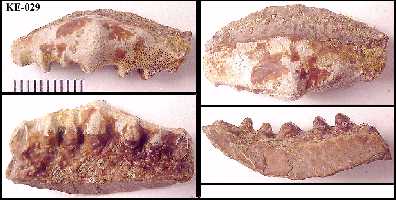 |
 |
Left: Smaller Cladodus
occidentalis tooth (upper row, left to right): lingual, labial, and
occlusal; (bottom row, left to right): lingual, lateral, lateral, basal. Right: Two Petalodus teeth, Lower Permian of Geary Co., KS. |
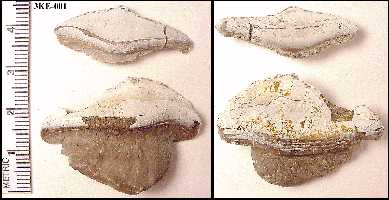 |
For more historical information on the discoveries of Kansas sharks, see also:
John Leidy: First report of shark remains from the "Paleozoic" rocks of Kansas discovered by Meek and Hayden.
Professor Benjamin Mudge - Early reports of Kansas sharks from both eastern and western Kansas.
Doctor George M. Sternberg - Dr. Sternberg made some of the first discoveries of Late Cretaceous sharks in western Kansas
Doctor John H. Janeway - Cope named a species of Ptychodontid shark after him, but the name is no longer used.
Suggested References:
Beamon, J. C. 1999. Depositional environment and fossil biota of a thin clastic unit of the Kiowa Formation, Lower Cretaceous (Albian), McPherson County, Kansas. Unpublished MS Thesis, Fort Hays State University, Hays, KS, 97 p.
Beeson, E. and K. Shimada. 2004. Vertebrates from a unique bonebed of the Upper Cretaceous Niobrara Chalk, western Kansas. Journal of Vertebrate Paleontology 24 (Supplement to Number 3): 37A.
Bourdon, J. and Everhart, M.J. 2010. Occurrence of the extinct Carpet shark, Orectoloboides, in the Dakota Formation (Late Cretaceous; Middle Cenomanian) of Kansas . Kansas Academy of Science, Transactions 113(3-4):237-242.
Bourdon, J. and Everhart, M.J. 2011. Analysis of an
associated Cretoxyrhina mantelli dentition from the Late Cretaceous (Smoky Hill
Chalk, Late Coniacian) of western Kansas . Kansas Academy of Science,
Transactions 114(1-2):15-32.
Caggiano, T. and M. J. Everhart, 2003. A rare occurrence of the Late Cretaceous ptychodontid shark, Ptychodus polygyrus Agassiz 1839, in the Smoky Hill Chalk Member (Niobrara Formation) of western Kansas. Kansas Acad. Science Abstracts, 22:28.
Cappetta, H., 1973. Selachians from the Carlile Shale (Turonian) of South Dakota. Jour. Paleon. 47(3):504-514.
Cappetta, H. and Case, G. R., 1987. Chondrichthyes II - Mesozoic and Cenozoic Elasmobranchii. Gustav Fischer Verlag, Stuttgart and New York. 193 p., 148 fig.
Cappetta, H. and Case, G. R., 1999. Additions aux faunes de selaciens du Cretace du Texas (Albien superier-Campanian). Paleo Ichthyologica 9:5-111, 8 fig. 1 table, 30 pls.
Case, G. R. 1965. An occurrence of the sawfish, Onchopristis dunklei, in the Upper Cretaceous of Minnesota. Journal, Minnesota Academy of Science, 32(3):183.
Case, G. R., T. T. Tokaryk and D. Baird. 1990. Selachians from the Niobrara Formation of the Upper Cretaceous (Coniacian) of Carrot River, Saskatchewan, Canada. Can. J. Earth Sci. 27:1085-1094.
Chorn, J. and D. Frailey, 1978. A large chondrichthyan spine, Physonemus mirabilis, from the Upper Pennsylvanian of Kansas, U.S.A. N. Jb. Geol. Paläont. Mh., (7):385-392, 1 fig.
Cicimurri, D., 2000. Early Cretaceous Elasmobranchs from the Newcastle Sandstone (Albian) of Crook County, Wyoming. The Mountain Geologist, 37(3):101-107.
Cicimurri, D., 2001. Fossil Selachians from the Belle Fourche Shale (Cretaceous, Cenomanian) Black Hills Region of South Dakota and Wyoming. The Mountain Geologist, 38(4):181-192.
Cicimurri, D., 2002. Chondrichthyes from the upper part of the Minnelusa Formation (Middle Pennsylvanian: Desmoinesian), Meade County, South Dakota. Proceedings of the South Dakota Academy of Science, 81:81-92.
Cicimurri, D., 200_. Cretaceous elasmobranchs of the Greenhorn Formation (Middle Cenomanian-Middle Turonian), western South Dakota. 6th Fossil Conference Proceedings volume. :27-43.
Cicimurri, D. J., D. C. Parris and M. J. Everhart. 2008. Partial dentition of a chimaeroid fish (Chondrichthyes, Holocephali) from the Upper Cretaceous Niobrara Chalk of Kansas, USA. Journal of Vertebrate Paleontology 28(1):34–40.
Cook, T.D., Wilson, M.V.H. and Newbrey, M.G. 2010. The first record of the large Cretaceous lamniform shark, Cardabiodon ricki, from North America and a new empirical test for its presumed antitropical distribution. Journal of Vertebrate Paleontology 30(3):643–649.
Cook, T.D, Wilson, M.V.H., Murray, A.M., Plint, A.G., Newbrey, M.G. and Everhart, M.J. 2013. A high latitude euselachian assemblage from the early Turonian of Alberta, Canada. Journal of Systematic Palaeontology 11(5):555-587.
Cope, E. D., 1875. The vertebrata of the Cretaceous formations of the West. Report, U. S. Geol. Surv. Terr. (Hayden). 2:302 p, 57 pls.
Cope, E. D., 1892. Characters of Paleozoic fishes. Proc. U.S. Nat. Museum. 14:447-463 (Ctenacanthus amblyxiphias Cope 1891)
Corrado, C. A., D. A. Wilhelm, K. Shimada, and M. J. Everhart. 2003. A new skeleton of the Late Cretaceous lamniform shark, Cretoxyrhina mantelli, from western Kansas. Journal of Vertebrate Paleontology, Volume 23 (Supplement to Number 3): 43A.(Abstract)
Cragin, F. W., 1895. A study of the Belvidere Beds. Amer. Geol. 16:357-385. (Kiowa Shale, Early Cretaceous)
Cumbaa, S.L., Shimada, K. and Cook, T.D. 2010. Mid-Cenomanian vertebrate
faunas of the Western Interior Seaway of North America and their evolutionary,
paleobiogeographical and paleoecological implications. Palaeogeography,
Palaeoclimatology, Palaeoecology 295:199-214.
Dibley, G. E., 1911. On the teeth of Ptychodus and their distribution in the English Chalk. Quart. Journal Geological Society London LXVII
Everhart, M. J. 2004. First record of the hybodont shark genus, “Polyacrodus” sp., (Chondrichthyes; Polyacrodontidae) from the Kiowa Formation (Lower Cretaceous) of McPherson County, Kansas. Kansas Academy of Science, Transactions 107(1/2): 39-43.
Everhart, M. J. 2004. Late Cretaceous interaction between predators and prey. Evidence of feeding by two species of shark on a mosasaur. PalArch, vertebrate palaeontology series 1(1):1-7. (see the webpage here)
Everhart, M. J. 2005. New stratigraphic records (Albian-Coniacian) of the guitarfish, Rhinobatos incertus (Chondrichthyes; Rajiformes), from the Cretaceous of central and western Kansas. Journal of Vertebrate Paleontology, 25(Supplement to 3): 55A.
Everhart, M. J. 2007. New stratigraphic records (Albian-Campanian) of the guitarfish, Rhinobatos sp. (Chondrichthyes; Rajiformes), from the Cretaceous of Kansas. Kansas Academy of Science, Transactions 110(3-4): 225-235.
Everhart, M.J. 2011. Occurrence of the hybodont shark genus Meristodonoides (Chondrichthyes; Hybodontiformes) in the Cretaceous of Kansas . Kansas Academy of Science, Transactions 114(1-2):33-46.
Everhart, M. J. and Caggiano, T. 2004. An associated dentition and calcified vertebral centra of the Late Cretaceous elasmobranch, Ptychodus anonymus Williston 1900. Paludicola, 4(4), p. 125-136.
Everhart, M. J., T. Caggiano and K. Shimada. 2003. Note on the occurrence of five species of ptychodontid sharks from a single locality in the the Smoky Hill Chalk (Late Cretaceous) of western Kansas. Kansas Acad. Sci. Abstracts, 22:29.
Everhart, M. J. and M. K. Darnell. 2004. Occurrence of Ptychodus mammillaris (Elasmobranchii) in the Fairport Chalk Member of the Carlile Shale (Upper Cretaceous) of Ellis County, Kansas. Kansas Academy of Science, Transactions 107(3-4):126-130.
Everhart, M. J. and P. A. Everhart, 1998. New data regarding the feeding habits of the extinct lamniform shark, Cretoxyrhina mantelli, from the Smoky Hill Chalk (upper Cretaceous) of western Kansas. Kansas Acad. Sci. Trans. 17:(Abstracts)33.
Everhart, M. J. and P. A. Everhart, 2003. First report of the Paleozoic shark, Ctenacanthus amblyxiphias Cope 1891 from the Lower Permian of Morris County Kansas. Kansas Acad. of Science Abstracts, 22:13.
Everhart, M. J., P. A. Everhart and K. Ewell. 2004. A marine ichthyofauna from the Upper Dakota Sandstone (Late Cretaceous). Abstracts of oral presentations and posters, Joint Annual Meeting of the Kansas and Missouri Academies of Science, p. 48.
Everhart, M. J., P. A. Everhart, E. M. Manning, and D. E. Hattin. 2003. A Middle Turonian marine fish fauna from the Upper Blue Hill Shale Member, Carlile Shale, of north central Kansas. Journal of Vertebrate Paleontology, Volume 23 (Supplement to Number 3): 49A.(Abstract)
Everhart, M. J., K. Shimada and K. Ewell. 2004. First record of the lamniform shark genus, Johnlongia, from the Niobrara Chalk. Abstracts of oral presentations and posters, Joint Annual Meeting of the Kansas and Missouri Academies of Science, p. 48.
Ewell, K. and M. J. Everhart. 2004. A Paleozoic shark fauna from the Council Grove Group (Lower Permian). Abstracts of oral presentations and posters, Joint Annual Meeting of the Kansas and Missouri Academies of Science, p. 48-49.
Gibbs, R. W., 1848. Monograph of the fossil Squalidae of the United States. Jour. Acad. Nat. Sci. Phila. Vol. 1, 2nd Ser., pt. 2, art. 12:139-147. pls. 18-21 (Ptychodus mortoni).
Hamm , S.A. 2010. The Late Cretaceous
shark, Ptychodus rugosus, (Ptychodontidae) in the Western Interior Sea . Kansas
Academy of Science, Transactions 113(1-2):44-55.
Hamm, S. A. and M. J. Everhart, 1999. The occurrence of a rare Ptychodontid shark from the Smoky Hill Chalk (upper Cretaceous) of Western Kansas. Kansas Acad. Sci. Trans. 18(Abstracts):34.
Hamm, S. A. and K. Shimada. 2002. Associated tooth set of the late Cretaceous lamniform shark, Scapanorhynchus raphiodon (Mitsukurinidae), from the Niobrara Chalk of Western Kansas. Kansas Acad. Sci. Trans. 105(1-2)18-26.
Hamm, S. A., K. Shimada and M. J. Everhart, 2003. Three uncommon lamniform sharks from the Smoky Hill Chalk (Upper Cretaceous) of western Kansas. Kansas Academy of Science Abstracts, 22:30-31.
Hansen, Michael C., 1986, Microscopic chondrichthyan remains from Pennsylvanian marine rocks of Ohio and adjacent areas: unpublished Ph.D. dissertation, The Ohio State University, 535 p.
Hattin, D. E., 1962. Stratigraphy of the Carlile Shale (Upper Cretaceous) in Kansas. State Geol. Surv. of Kansas, Bull. 156, (University of Kansas pub.) 155 p. 2 pl.
Hattin, D. E., 1965. Stratigraphy of the Graneros Shale (Upper Cretaceous in central Kansas. Bulletin 178, Kansas Geological Survey, 83 pp.
Hattin, D. E., 1975. Stratigraphy and depositional environment of the Greenhorn Limestone (Upper Cretaceous) of Kansas. Bulletin 209, Kansas Geological Survey, 128 pp.
Hattin, D. E., 1982. Stratigraphy and depositional environment of the Smoky Hill Chalk Member, Niobrara Chalk (Upper Cretaceous) of the type area, western Kansas. Kansas Geological Survey Bulletin 225, 108 pp.
Hattin, D. E. and C. T. Siemers, 1978. Upper Cretaceous stratigraphy and depositional environments of western Kansas. Guidebook Series 3, AAPG/SEPM annual meeting, Kansas Geological Survey, 55 pp. (Reprinted 1987.
Itano, W. M., K. J. Houck, and M. G. Lockley. 2003. Ctenacanthus and other chondrichthyan spines and denticles from the Minturn Formation (Pennsylvanian) of Colorado. Jour. Paleon. 77(3):524-535.
Kirkland, J. I., 1989. Fossil elasmobranchs from the mid Cretaceous (Middle Cenomanian Middle Turonian) Greenhorn Cyclothem of eastern Nebraska. Proc. Nebraska Acad. Sci., Ninety ninth Annual Meeting, p. 52. (Abstract)
Kirkland, J. I., 1996. Paleontology of the Greenhorn cyclothem (Cretaceous: Late Cenomanian to middle Turonian) at Black Mesa, northeastern Arizona. New Mexico Museum of Natural History and Science, Bull. 9, 131 p., 50 pls. (I have pages 110-113 listing vertebrate remains). <EM>
Leidy, J., 1859. [Xystracanthus, Cladodus and Petalodus from the Carboniferous of Kansas]. Proc. Acad. Nat. Sci. Phila., 11:3. <EM>
Lucas, S. G., 2002. The first vertebrate fossil described from New Mexico.
New Mexico Geologist 24(2):49. (P. whipplei)
Lucas, S. G., B. S. Kues, S. N. Hayden, B. D. Allen, K. K. Kietzke, T. E.
Williamson, P. Sealey and R. Pence, 1988. Cretaceous stratigraphy and
biostratigraphy, Cooke's Range, Luna County, New Mexico. New Mexico Geological
Society Guidebook, 39th Field Conference, Southwestern New Mexico, pp. 143-167.
Lucas, S. G., P. K. Reser, and D. L. Wolberg, 1985. Shark vertebrae from the upper Cretaceous Pierre Shale, northeastern New Mexico. New Mexico Bureau of Mines and Mineral Resources Circular 195, pp. 21-23.
Maisey, J. G., 1975. The interrelationships of phalacanthous selachians. N. Jb. Geol. Paläont. Mh. 9:553-567, 6 fig.
Maisey, J. G., 1977. Structural notes on a cladoselachian dorsal spine. N. Jb. Geol. Paläont. Mh. 1:47-55, 6 fig.
Maisey, J. G., 1982. Studies on the Paleozoic selachian genus Ctenacanthus No. 2. Bythiacanthus St. John and Worthen, Amelacanthus St. John and Worthen, Sphenacanthus Agassiz, and Wodnika Münster. American Museum Noviates, 2722:1-24.
Maisey, J. G., 1984. Studies on the Paleozoic selachian genus Ctenacanthus Agassiz. No. 3.: Nominal species referred to Ctenacanthus. American Museum Noviates, 2774:1-20.
Maisey, J. G., 1996. Discovering Fossil Fishes. Henry Holt and Company, New York.
Manning, E. M. and D. T. Dockery III., 1992. A guide to the Frankstown vertebrate fossil locality (upper Cretaceous), Prentiss County, Mississippi. Mississippi Dept. Env. Qual., Office of Geo. Circular 4, 43 p. 2 pl.
Marcou, J., 1858. Geology of North America, with two reports on the prairies of Arkansas and Texas, the Rocky Mountains of New Mexico, and the Sierra Nevada of California, originally made for the United States Government. Pp. i-vi, 1-144, with 7. (fig. and naming of P. whipplei)
McLeod, N., 1982. The first North American occurrence of the Late
Cretaceous elasmobranch Ptychodus rugosus
Dixon with comments on the functional morphology of the dentition and dermal
denticles. Jour. Paleon., 56(2):403-409.
McLeod, N. and B. H. Slaughter. 1980. A new ptychodontid from the Upper
Cretaceous of Texas. Texas Jour. Sci. 32(4):333-335.
McKinzie, M. G., R. Morin, and E. Swiatovy. 2001. Fossil collector's guidebook to the North Sulphur River [Texas]. Occasional Papers, Dallas Paleontological Society, Vol. 4, 119 pp., 20 pl.
McNulty, C. L. Jr. and B. H. Slaughter. 1962. A new sawfish from the Woodbine Formation (Cretaceous) of Texas. Copeia 1962(4):775-777.
McNulty, C. L. Jr. and B. H. Slaughter. 1964. Rostral teeth of Ischyrhiza mira Leidy from northeast Texas. Texas Jour. Sci. 16:107-112, 1 pl.
McNulty, C. L. Jr. and B. H. Slaughter. 1972. The Cretaceous selachian genus, Ptychotrygon Jaekel 1894. Eclog. Geol. Helvetiae 65(3):647-656, 1 pl. <EM>
Meyer, R. L. 1974. Late Cretaceous elasmobranchs from the Mississippi and East Texas embayments of the Gulf Coastal Plain. Unpublished Doctoral dissertation, Southern Methodist University, Dallas, 419 pp.
Morton, S. G. 1834. Synopsis of the organic remains of the Cretaceous group of the United States. Key and Biddle, Philadelphia, 88 pp., 19 pl.
Morton, S. G. 1842. Description of some new species of organic remains of the Cretaceous group of the United States; with a tabular view of the fossils hitherto discovered in this formation. Jour. Acad. Nat. Sci. Phila. viii pp. 207-227, pls. x, xi.
Mudge, B. F. 1866. First Annual Report on the Geology of Kansas. State Printer. 57 pp. (first 15 pages only)
Mudge, B. F., 1874. Rare forms of fish in Kansas. Kansas Acad. Sci. Trans. 3:121-122 (Agassizodus tooth plate and Protosphyraena)
Mudge, B. F. 1876. Notes on the Tertiary and Cretaceous periods of Kansas. Bull. U.S. Geol. Surv. Terr. (Hayden), 2(3):211-221.
Mudge, B. F. 1877. Annual Report of the Committee on Geology, for the year ending November 1, 1876. Kansas Acad. Sci. Trans., Ninth Annual Meeting, pp. 4-5. (discovery of Uintacrinus socialis in Kansas, Pteranodon, sharks and birds.)
Romer, A. S. 1942. Notes on certain American Paleozoic fishes. Amer. Jour. Sci., 240:216-228, 1 pl.
Russell, D. A. 1988. A check list of North American marine cretaceous vertebrates Including fresh water fishes, Occasional Paper of the Tyrrell Museum of Palaeontology, (4):57.
Schultze, H.-P., J. D. Stewart, A. M. Neuner and R. W. Coldiron. 1982. Type and figured specimens of fossil vertebrates in the collection of the University of Kansas Museum of Natural History. Part I. Fossil fishes. Misc. Pub. Univ. Kansas Mus. Nat. Hist. 73:53 pp.
Scott, R. W. 1970. Paleoecology and paleontology of the Lower Cretaceous Kiowa Formation, Kansas. The University of Kansas Paleontological Contributions, Article 52, 94 pp.
Shimada, K. 1993. Upper Cretaceous elasmobranchs from the Blue Hill Shale Member of the Carlile Shale, Western Kansas. Kansas Academy of Science Abstracts, 12(78).
Shimada, K. 1993. Upper Cretaceous selachians from the Fort Hays Limestone Member of the Niobrara Formation in Ellis County, Kansas. Kansas Academy of Science Abstracts, 12(78).
Shimada, K. 1994. Paleobiology of the Late Cretaceous shark, Cretoxyrhina mantelli (Lamniformes: Cretoxyrhinidae), from Kansas. Unpubl. Masters thesis. 169 pp. Fort Hays State University.
Shimada, K. 1996. Selachians from the Fort Hays Limestone Member of the Niobrara Chalk (Upper Cretaceous), Ellis County, Kansas. Kansas Acad. Sci. Trans. 99(1-2):1-15.
Shimada, K. 1997a. Dentition of the late Cretaceous lamniform shark, Cretoxyrhina mantelli, from the Niobrara Chalk of Kansas. Journ. Vert. Paleon. 17(2):269-279.
Shimada, K. 1997b. Shark-tooth-bearing coprolite from the Carlile Shale (upper Cretaceous), Ellis County, Kansas. Kansas Acad. Sci. Trans. 100(3-4):133-138.
Shimada, K. 1997c. Stratigraphic record of the late Cretaceous lamniform shark, Cretoxyrhina mantelli (Agassiz), in Kansas. Kansas Acad. Sci. Trans. 100(3-4):139-149.
Shimada, K. 1997d. Gigantic lamnoid shark vertebra from the lower Cretaceous Kiowa Shale of Kansas. Journ. Paleon. 71(3):522-524.
Shimada, K. 1997e. Paleoecological relationships of the late Cretaceous lamniform shark, Cretoxyrhina mantelli (Agassiz). Journ. Paleon. 71(5):926-933.
Shimada, K., 1997f. Periodic marker bands in vertebral centra of the late Cretaceous lamniform shark, Cretoxyrhina mantelli. Copeia (1):233-235.
Shimada, K. 2005. Skeletal and dental anatomy of the Late Cretaceous lamniform shark Cretalamna (= Cretolamna) appendiculata. Journal of Vertebrate Paleontology 25 (Supplement to 3):114A-115A.
Shimada, K. 2008. Ontogenetic parameters and life history strategies of the Late Cretaceous lamniform shark, Cretoxyrhina mantelli, based on vertebral growth increments. Journal of Vertebrate Paleontology 28(1):21-33.
Shimada, K. and Cicimurri, D.J. 2005. Skeletal anatomy of the Late Cretaceous shark, Squalicorax (Neoselachii: Anacoracidae). Paläontologische Zeitschrift 79(2): 241-261.
Shimada, K., K. Ewell and M. J. Everhart. 2004. The first record of the lamniform shark genus, Johnlongia, from the Niobrara Chalk (Upper Cretaceous, western Kansas. Kansas Academy of Science, Transactions 107(3/4):131-135.
Shimada, K and M. J. Everhart. 2003. Ptychodus mammillaris (Elasmobranchii) and Enchodus cf. E. schumardi (Teleostei) from the Fort Hays Limestone Member of the Niobrara Chalk (Upper Cretaceous) in Ellis County, Kansas. Kansas Academy of Science, Transactions 106(3-4):171-176.
Shimada, K. and M. J. Everhart. 2004. Shark-bitten Xiphactinus audax (Teleostei: Ichthyodectiformes) from the Niobrara Chalk (Upper Cretaceous) of Kansas. The Mosasaur 7, p. 35-39.
Shimada, K. and D. J. Martin. 1993. Upper Cretaceous selachians from the basal Greenhorn Limestone in Russell Co., Kansas. Kansas Academy of Science Abstracts, 12(78).
Siverson, M. 1992. Biology, dental morphology and
taxonomy of lamniform sharks from the Campanian of the Kristianstad Basin,
Sweden. Palaeontology 35:519–554.
Siverson, M. 1996. Lamniform sharks of the mid
Cretaceous Alinga Formation and
Siverson, M. 1997. Sharks from the mid-Cretaceous Gearle
Siltstone, southern
Siverson, M. 1999. A new large lamniform shark from the uppermost Gearle
Siltstone (Cenomanian, Late Cretaceous) of Western Australia. Transactions of
the Royal Society of Edinburgh: Earth Sciences, 90:49-66.
Siverson, M. and J. Lindgren. 2005. Late Cretaceous sharks
Cretoxyrhina and
Cardabiodon from Montana, USA. Acta
Palaeontol. Pol. 50(2) 301-314.
Siverson, M., Lindgren, J., Newbrey, M.G., Cederström, P. and Cook, T.D. 2013. Late Cretaceous (Cenomanian-Campanian) mid-palaeolatitude sharks of Cretalamna appendiculata type. Acta Palaeontologica Polonica 5X (X): 46 pp.
Slaughter, B. H. and M. Steiner. 1968. Notes on rostral teeth of Ganopristine sawfishes, with special reference to Texas material. Jour. Paleon. 42(1):233-239.
Stewart, J. D. 1980. Reevaluation of the phylogenetic position of the Ptychodontidae. Kansas Academy of Science, Transactions 83(3):154. (abstract)
Stewart, J. D. 1990. Niobrara Formation vertebrate stratigraphy, pages 19-30, In Bennett, S. C. (ed.), Niobrara Chalk Excursion Guidebook, The University of Kansas Museum of Natural History and the Kansas Geological Survey.
Stewart, J. D. and J. E. Martin. 1993. Late Cretaceous selachians and associated marine vertebrates from the Dakota Rose Quarry, Grant County, South Dakota. Proc. S. D. Acad. Sci. 72:241-248.
Underwood, C.J. and Cumbaa, S.L. 2010. Chondrichthyans from a Cenomanian
(Late Cretaceous) bonebed, Saskatchewan, Canada. Palaeontology 53(4):903-944.
Welton, B. J. and R. F. Farish. 1993. The collectors guide to fossil sharks and rays from the Cretaceous of Texas. Horton Printing Company, Dallas, 204 pp.
Whitley, G. P. 1939. Taxonomic notes on sharks and rays. Australian Journal of Zoology 9(3):227–262.
Williamson, T. E., J. I. Kirkland and S. G. Lucas. 1993. Selachians from
the Greenhorn cyclothem ("Middle" Cretaceous: Cenomanian-Turonian), Black Mesa,
Arizona, and the paleogeographic distribution of Late Cretaceous selachians. J.
Paleon. 67(3):447-474.
Williamson, T. E., S. G. Lucas and J. I. Kirkland. 1990. The Cretaceous
elasmobranch Ptychodus decurrens
Agassiz from North America. Geobios 24(5):595-599.
Williamson, T. E. and S. G. Lucas. 1992. Selachian fauna from the Upper
Cretaceous (Coniacian) El Vado Sandstone Member of the Mancos Shale, San Juan
Basin, New Mexico. New Mexico Geological Society Annual Field Conference,
Guidebook 43, pp. 17-19.
Williamson, T. E., S. G. Lucas, and R. Pence. 1989. Selachians from the Hosta
Tongue of the Point Lookout Sandstone (Upper Cretaceous, Santonian), central New
Mexico. New Mexico Geological Society Guidebook, 40th Field Conference,
Southeastern Colorado Plateau, pp. 239-245.
Williston, S. W. 1900. Cretaceous fishes [of Kansas]. Selachians and Pycnodonts. University Geological Survey Kansas VI pp. 237-256, with pls.
Woodward, A. S. 1887. On the dentition and affinities of the selachian genus Ptychodus Agassiz. Quart. Jour. Geol. Soc. xliii pp. 121-131, with pl. x.
Woodward, A.S. 1904. On the jaws of Ptychodus from the chalk. Quarterly Journal Geological Society London 60:133-136, 1 fig., pl. XV.
Zangerl, R. 1973. Interrelationships of early chondrichthyans. Pages 1-14 In Greenwood, P. H., R. S. Miles, and C. Patterson, Interrelationships of fishes. Supplement No. 1 to the Zoological Journal of the Linnean Society, Vol. 53.
Zangerl, R. 1981. Chondrichthyes I - Paleozoic Elasmobranchii. 3a:1-115 In Shultze, H-P. (ed.), Handbook of Paleoichthyology. Gustav Fischer Verlag, Stuttgart and New York.
Zielinski, S. L. 1994.First report of Pycnodontidae (Osteichthyes) from the Blue Hill Shale Member of the Carlile Shale (Upper Cretaceous; Middle Turonian), Ellis County, Kansas. Kansas Academy of Science, Abstracts 13(44).
Zidek, J., 1976. Oklahoma Paleoichthyology Part V: Chondrichthyes. Oklahoma Paleontology Notes, 36(5):175-192, Oklahoma Geol. Surv., Norman, OK.
